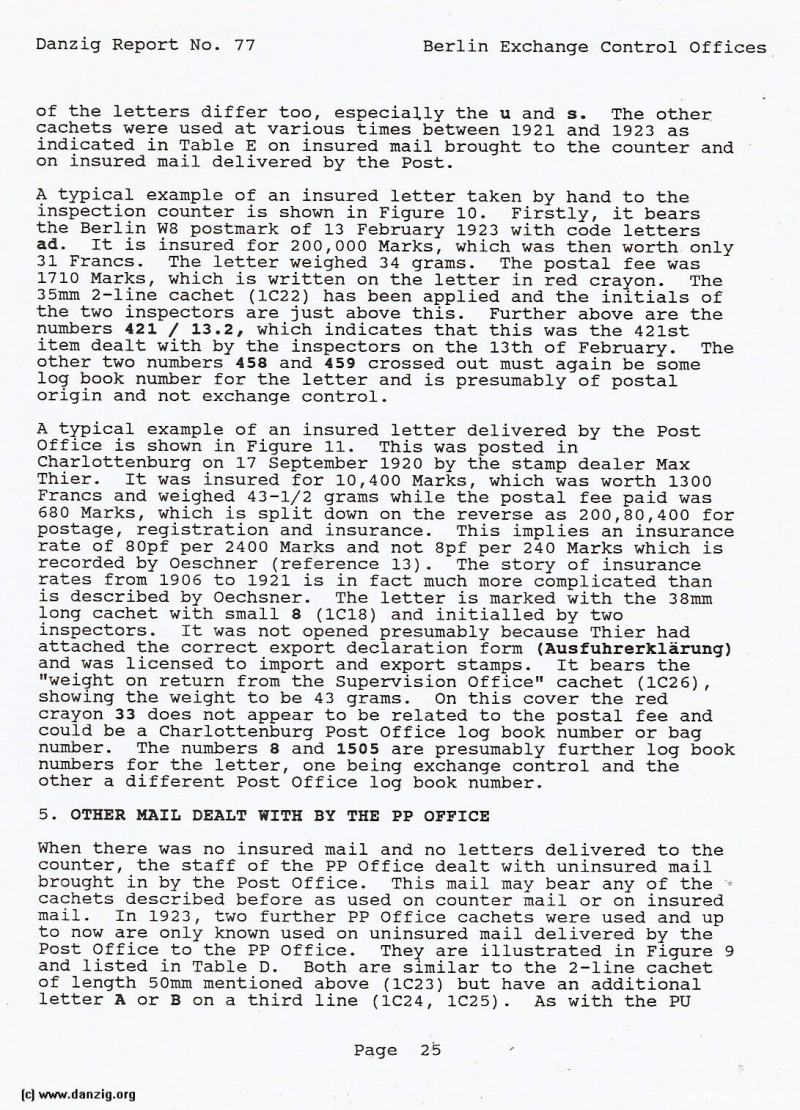
of the letters differ too, especially the u and s. The other cachets were used at various times between 1921 and 1923 as indicated in Table E on insured mail brought to the counter and on insured mail delivered by the Post.
A typical example of an insured letter taken by hand to the inspection counter is shown in Figure 10. Firstly, it bears the Berlin W8 postmark of 13 February 1923 with code letters ad. It is insured for 200,000 Marks, which was then worth only 31 Francs. The letter weighed 34 grams. The postal fee was 1710 Marks, which is written on the letter in red cra’on. The
35mm 2-line cachet (1C22) has been applied and the initials of the two inspectors are just above this. Further above are the numbers 421 / 13.2, which indicates that this was the 421st item dealt with by the inspectors on the 13th of February. The other two numbers 458 and 459 crossed out must again be some log book number for the letter and is presumably of postal origin and not exchange control.
A typical example of an insured letter delivered by the Post Office is shown in Figure 11. This was posted in Charlottenburg on 17 September 1920 by the stamp dealer Max Thier. It was insured for 10,400 Marks, which was worth 1300 Francs and weighed 43—1/2 grams while the postal fee paid was 680 Marks, which is split down on the reverse as 200,80,400 for postage, registration and insurance. This implies an insurance rate of 8Opf per 2400 Marks and not 8pf per 240 Marks which is recorded by Oeschner (reference 13). The story of insurance rates from 1906 to 1921 is in fact much more complicated than is described by Oechsner. The letter is marked with the 38mm long cachet with small 8 (1C18) and initialled by two inspectors. It was not opened presumably because Thier had attached the correct export declaration form (Ausfi.threrklarung) and was licensed to import and export stamps. It bears the “weight on return from the Supervision Office” cachet (1C26), showing the weight to be 43 grams. On this cover the red crayon 33 does not appear to be related to the postal fee and could be a Charlottenburg Post Office log book number or bag number. The numbers 8 and 1505 are presumably further log book numbers for the letter, one being exchange control and the other a different Post Office log book number.
5. OTHER MAIL DEALT WITH BY THE PP OFFICE
When there was no insured mail and no letters delivered to the counter, the staff of the PP Office dealt with uninsured mail brought in by the Post Office. This mail may bear any of the cachets described before as used on counter mail or on insured mail. In 1923, two further PP Office cachets were used and up to now are only known used on uninsured mail delivered by the Post Office to the PP Office. They are illustrated in Figure 9 and listed in Table D. Both are similar to the 2-line cachet of length 50mm mentioned above (1C23) but have an additional letter A or B on a third line (1C24, 1C25). As with the PU
Danzig Report Vol. 1 - Nr. 77 - October - November - December - 1992, Page 25.
Hits: 1559
Added: 03/07/2015
Copyright: 2024 Danzig.org

